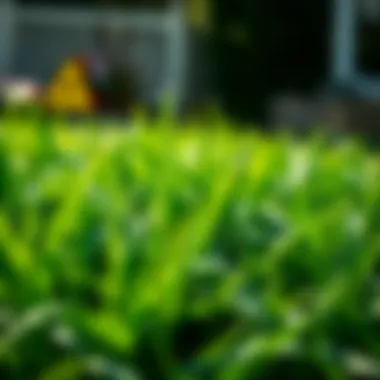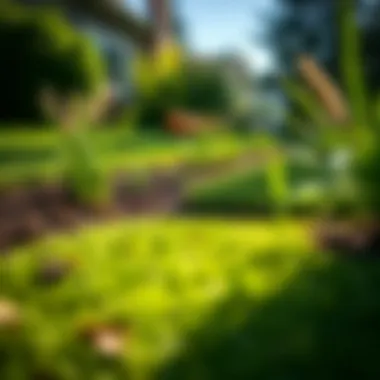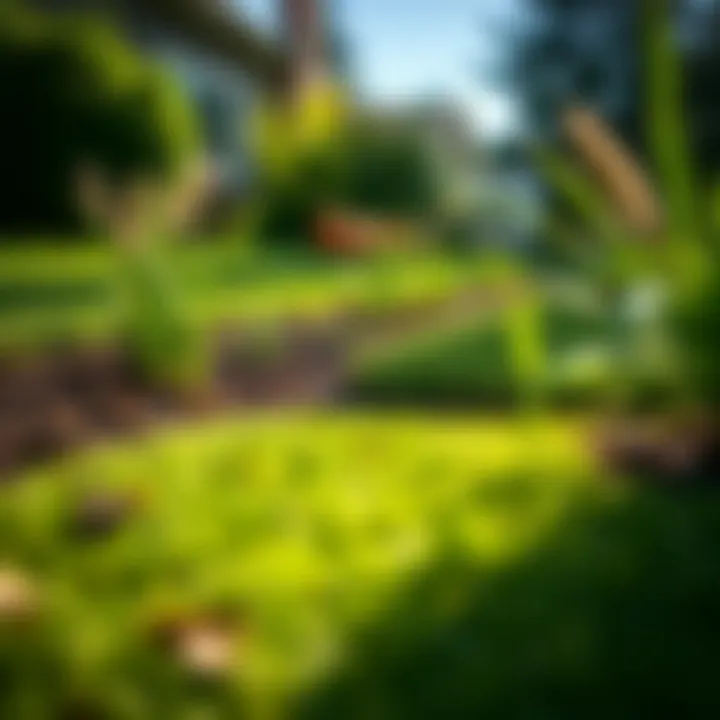Best Grass Varieties for Moisture-Prone Yards


Intro
Selecting the right type of grass for wet yards can seem like navigating a maze blindfolded. Without proper guidance, homeowners often find themselves in a sticky situation. Grass types vary significantly in their ability to handle moisture, which is crucial for those dealing with soggy grounds. This guide seeks to provide clarity on which grasses are best suited for wet environments, helping you transform a challenging lawn into a lush oasis.
In many regions, constant rainfall or poor drainage can lead to a swampy yard, presenting headaches for even the most seasoned gardeners. Understanding the unique characteristics of various grass types ensures that your choices align with the specific conditions of your landscape. Let's dig into the common traits found in moisture-loving grasses and explore what makes each option viable for your green space.
Understanding Wet Yards
Understanding what a wet yard entails is crucial for homeowners and gardening enthusiasts looking to select the right kind of grass for their lawn. Wet yards present unique challenges and opportunities, primarily due to their characteristic moisture saturation. High levels of moisture can impact the growth patterns of various grass types, leading to a landscape that can either thrive or struggle depending on the choices made.
First and foremost, recognizing a wet yard is about more than just knowing it gets waterlogged. It’s about understanding how that wetness affects soil composition, drainage capabilities, and the types of plants that can survive in these conditions. Grass selection is deeply influenced by these environmental factors. Choosing grass that naturally adapts to moisture-rich conditions not only promotes growth but can significantly reduce maintenance efforts.
Moreover, a wet yard often offers its own set of benefits. For instance, the lushness of a healthy, thriving green space can be visually appealing and provide a habitat for local wildlife. However, without proper care and understanding of its unique requirements, a wet yard can become a breeding ground for issues like mold, pests, or weeds that thrive on excess moisture.
In summary, grasping the dynamics of wet yards invites a more educated approach towards landscaping. It paves the way for strategies that ensure that even in wet conditions, the backyard can flourish into a verdant haven.
Defining a Wet Yard
A wet yard can generally be defined as one that retains excess moisture, often characterized by soaked or mucky soil. It tends to exhibit slow draining capabilities, making it challenging for certain grass types to establish or thrive without additional interventions. Homeowners might find themselves in this category if their property experiences standing water after rainfall or has soil that feels perpetually damp. This situation is particularly common in low-lying areas or regions prone to heavy rains.
Common Causes of Wetness
Understanding the common causes of wetness in yards helps homeowners identify the source of their water retention problems.
Excess Rainfall
Excess rainfall is often the most apparent cause of wet yards, especially in regions where precipitation is frequent or intense. During heavy downpours, the sheer volume of water can saturate the ground beyond its capacity to absorb, leaving the surface muddy and unyielding. Not only does this make certain grass types less viable, but too much water can also lead to harmful fungal diseases in existing vegetation. It's essential to observe the rainfall patterns typical of one's region—knowing when to plant grass that can withstand such inundation is vital for a successful lawn.
Poor Drainage
Poor drainage typically stems from various factors, including compacted soil or a lack of effective grading on the property. Standing water is a direct result of this drainage issue. Even with manageable rainfall, if water cannot move from one area to another, it contributes to an ongoing wet condition in specific sections of a yard. Addressing drainage problems requires a closer examination of landscape design and may involve integrating drainage solutions or modifying soil conditions to facilitate better runoff.
High Water Table
A high water table indicates that groundwater is near the soil surface, making it difficult for surface water to drain. In situations where the water table is consistently high—especially following rainy seasons—the yard may seem perpetually wet. Homeowners in these situations should focus on selecting drought-tolerant or water-resistant grass varieties that can adapt to high moisture without succumbing to rot or disease. Understanding the local geology and hydrology can aid in developing long-term solutions for managing high water tables effectively.
"Grasping the nuance of what leads to a wet yard is half the battle; the other half lies in knowing how to cultivate it effectively."
Characteristics of Grass for Wet Conditions
Choosing the right grass for wet conditions isn't just about aesthetics; it's about ensuring the health and sustainability of your lawn. Grass types compatible with moisture-rich environments must possess certain characteristics that allow them to thrive despite potential challenges like root rot or nutrient deficiency due to stagnant water. Understanding these attributes can steer homeowners and enthusiasts towards more informed choices, minimizing upkeep while maximizing the vibrancy of their greenspaces.
Drought Resistance
In an irony of nature, even the most water-logged areas can face spells of drought. While it may seem counterintuitive, drought resistance is a beneficial trait for grasses in wet yards. The underlying soil is not always saturated, and periods of dryness can occur unexpectedly. Grasses like Tall Fescue exhibit deep root systems that allow them to tap into subsoil moisture efficiently. This flexibility is crucial as it ensures that when rain is scarce, the grass can still draw hydration from lower soil layers, promoting longevity and a lush appearance. Furthermore, drought-resistant grasses become resilient to sudden weather fluctuations, cutting down on the need for constant irrigation
- Benefits:
- Reduces watering frequency
- Sustains lawn health during dry spells
- Enhances overall resilience against environmental changes
Tolerance to Waterlogged Soil
When we talk about wet yards, tolerance to waterlogged soil can’t be overlooked. Certain grass types have evolved to manage excess moisture, which can suffocate the roots of standard grass varieties. Species like Creeping Bentgrass are known for their adaptable root systems that can survive prolonged saturation, a common scenario in many wet yards. Their structure not only withstands water but also helps in stabilizing the soil, preventing erosion and runoff. So, when selecting grass, it's crucial to focus on those specifically bred for such challenging conditions, ensuring that your lawn doesn't become a breeding ground for disease due to poor drainage. Here are some key propertities to consider:
- Key Attributes:
- Develops fibrous root systems
- Drains excess water effectively
- Limits the onset of mold and fungus
Suitability for Different Light Conditions


Another important characteristic of grass species for wet yards is their adaptability to various light conditions. Not all landscapes bask in full sun; some shaded areas can have completely different moisture dynamics. Grasses like Perennial Ryegrass are tailor-made for partial shade, while others may seek out bright sunlight. Understanding the sunlight conditions of your yard will ultimately determine which type of grass will flourish. Grasses that can cope with varying light levels tend to be healthier and more vibrant, contributing to a harmonized ecosystem in your yard. Factors to consider include:
- Light Requirements:
- Full sun vs. shade tolerance
- Impacts on moisture retention
- Selecting compatible species for your unique yard layout
“Selecting the right grass type for your wet yard is like finding the right partner—compatibility is key.”
In summary, identifying grasses tailored for wet conditions isn't just about picking a pretty green. By understanding drought resistance, waterlogged tolerance, and light suitability, you're setting the stage for a thriving lawn that can weather whatever nature throws its way.
Grass Types for Wet Yards
When dealing with a wet yard, it’s essential to choose the right grass types that can thrive in such conditions. Grass varieties that flourish in moist environments not only maintain a lush appearance but also contribute to the health of your landscape. Selecting appropriate grass types reduces maintenance efforts and enhances the overall resilience of your yard against soggy situations. The right choice can prevent issues like soil erosion and flooding while promoting healthier biodiversity.
Perennial Ryegrass
Advantages
One of the standout features of perennial ryegrass is its rapid establishment. It hangs in there under wet conditions, and the deep roots assist in keeping the soil aerated. That means less chance of soil compaction, which can be a problem in soggy areas. Moreover, it holds up against foot traffic fairly well, making it suitable for family yards or properties that see a lot of activity. All these benefits make perennial ryegrass a popular option for anyone tackling wet yard challenges.
Growth Requirements
Growing perennial ryegrass is not overly complicated. It requires fertile, well-draining soil and contributes significantly to soil quality. The ideal pH level is between 6.0 and 7.0, and it enjoys moderate levels of sunlight. If you want a lush lawn, consistent watering is necessary, especially during dry spells. Just keep in mind, too much water can lead to disease, which is a consideration for those dealing with exceptionally wet conditions.
Tall Fescue
Advantages
The primary advantage of tall fescue lies in its versatility. It offers a durable turf that is adaptable to varying moisture levels and can handle moderate foot traffic well. Additionally, it requires less frequent watering once established, making maintenance a breeze. Because it can adapt to different lighting conditions, homeowners can plant it in shaded areas or direct sun without worrying about it wilting away.
Growth Requirements
For optimal growth, tall fescue needs well-drained soil, and while it does okay in wet conditions, excessive water can be detrimental. It thrives in temperatures ranging from 60 to 80 degrees Fahrenheit. While it doesn’t require as much fertilization as other grass types, providing it with a solid nitrogen feed will promote robust growth. This adaptability makes it a prime candidate for homeowners facing moisture troubles.
Kentucky Bluegrass
Advantages
One of the most appealing traits of Kentucky bluegrass is its ability to self-repair, thanks to the rhizomes that grow underground. This resiliency helps maintain a full, vibrant lawn even after heavy rains or foot traffic. Moreover, it can establish a thick mat, aiding in moisture retention while also mitigating runoff during heavy rains. Its deep green hue also provides an appealing aesthetic in comparison to other grasses.
Growth Requirements
For Kentucky bluegrass to reach its full potential, it requires fertile, loamy soil and benefits from a pH between 6.0 and 7.0. It is especially sensitive to waterlogged soil, meaningful consideration for wet yards. It prefers full sun but can tolerate a fair amount of shade as well. Proper fertilization and regular mowing can boost its health, thus enhancing its resistance to disease and pests.
Bermudagrass
Advantages
An asset of Bermudagrass is its aggressive growth habit, which allows it to fill in bare spots quickly. This grass tolerates heat exceptionally well and once established, it can also resist pests and diseases better than many other types. The thick layer of growth it forms acts as a defense against the elements, ensuring a resilient turf in various conditions.
Growth Requirements
To grow Bermudagrass effectively, it needs full sun and well-draining sandy or loamy soils. It performs optimally at temperatures around 75 to 100 degrees Fahrenheit. Proper mowing, around one to two inches, along with regular fertilization, can help maximize its growth potential while maintaining its robust appearance. While it’s not as tolerant of shade, its ability to adapt to humid conditions makes it a worthy addition to wet yards.
Creeping Bentgrass
Advantages
This grass is favored for its ability to create incredibly smooth surfaces, making it ideal for sport-related applications. Additionally, due to its dense growth, it helps in weed prevention, keeping the yard looking tidy and well-kept. Creeping bentgrass’s ability to tolerate moisture makes it resilient against oversaturation, meaning it can endure wet spells without significant damage.
Growth Requirements


To thrive, creeping bentgrass prefers well-aerated soil and a pH level of around 6.0 to 7.0. It enjoys full sun but can adapt to partial shade. However, it requires consistent maintenance, including frequent mowing and watering to avoid thatch buildup and maintain a healthy lawn. While it may require more attention than others, its lush and aesthetically pleasing results can often make the effort worthwhile.
Establishing Grass in Wet Conditions
Establishing grass in wet conditions requires careful planning and attention to specific elements that influence the growth and health of the turf. In areas prone to excess moisture, such as wet yards, simply selecting the right grass type is not enough. The process of setting up a thriving lawn begins with understanding various factors that can impact growth in these challenging environments. This section explores key elements, such as soil preparation techniques, effective seeding strategies, and the timing of seeding. Each of these plays an essential role in ensuring your lawn flourishes despite the challenges associated with high moisture levels.
Soil Preparation Techniques
The foundation of a resilient lawn rests in the soil, and for wet yards, the soil preparation stage is crucial. Start by evaluating the current soil conditions. Is it clay-heavy or sandy? Does it retain water or drain it effectively? Once you have a good grasp of the soil's characteristics, start with the following techniques:
- Aeration: This process involves perforating the soil with holes to allow air, water, and nutrients to penetrate. In wet conditions, aeration helps alleviate compaction, promoting better drainage.
- Amending with Organic Matter: Mixing in compost or well-rotted manure can improve soil structure, enhancing its ability to retain nutrients and moisture. This practice can also help with drainage by breaking up heavy clay soils.
- Testing pH Levels: It's wise to know your soil's pH, as certain grasses thrive in acidic, neutral, or alkaline soils. Adjustments can be made using lime or sulfur to create an ideal growing environment.
Preparing the soil not only boosts the likelihood of successful establishment but also sets the stage for healthy grass growth in the future.
Optimal Seeding Strategies
Once the soil is primed and ready, the next step is to adopt suitable seeding strategies designed to accommodate wet conditions. Some vital pointers include:
- Choosing the Right Seed Mix: Certain grass species are better adapted to wet environments. Consider grasses like Perennial Ryegrass and Creeping Bentgrass for their moisture tolerance.
- Seeding Rate: This can vary based on the grass type but err on the side of slightly more seeds to increase the likelihood of achieving a dense lawn. For instance, high-density seeding can help crowd out weeds that thrive in moist areas.
- Methods of Seeding:
- Broadcast Seeding: This is a common method and works well for smaller areas. Spread the seed evenly across the soil.
- Drill Seeding: For larger plots, this method ensures optimal seed-to-soil contact, which is critical in wet conditions.
These strategies help ensure that seeds have the best chance of germinating in a moisture-rich environment, leading to a lush, vibrant lawn.
Timing of Seeding
Timing is another crucial aspect of establishing grass in wet conditions. Grass has specific peak growing seasons, and wet yards often experience additional factors like extreme wetness or drying spells that impact germination. Here are some guidelines for timing:
- Spring and Early Fall: These seasons are generally ideal for seeding across much of the country. However, in wet climates, early spring may see more variability in moisture. Watch the forecast closely and consider seeding at the first sign of consistent warm weather after frost.
- Avoiding the Wettest Months: If local weather patterns show a tendency for prolonged wetness during specific months, plan your seeding accordingly. Timing your efforts just before expected rain can help ensure that your seeds have moisture to thrive without being overwhelmed.
- Observation: Pay attention to local growing trends and adjust your timing as necessary to achieve the best results. Recording rainfall patterns or observing other lawns in your area can provide valuable insights.
Choosing the right timing can make a world of difference in the establishment process, offering your grass the optimal conditions it needs to take root and thrive.
Establishing grass in wet conditions requires diligence, awareness of local conditions, and practical strategies tailored to the unique challenges of moisture-rich environments.
Maintenance of Grass for Wet Yards
Maintaining grass in wet yards is crucial for several reasons. First, wet conditions can lead to unique challenges that differ significantly from those in drier landscapes. These challenges might include diseases, pests, and nutrient deficiencies. A well-maintained lawn not only looks good but also promotes a healthier ecosystem overall. Addressing the special needs of grass in these conditions can yield long-term benefits, ensuring that your yard remains lush and vibrant.
Watering Practices
Watering might sound simple, yet it requires careful consideration in wet yards. The soil is already saturated, so additional watering should be approached with caution. This doesn’t mean neglecting the grass, though. In fact, over-watering can cause more harm than good by promoting root rot and other issues.
To optimize watering practices in wet yards, consider these key points:
- Monitor Soil Moisture: Use tools like a soil moisture meter to gauge when the grass actually needs water. It’s easy to think more water is better, but that isn't always the case in a soggy setting.
- Timing Is Everything: Water early in the morning or later in the evening to reduce evaporation and ensure the water reaches the roots, rather than sitting on the surface.
- Avoid Compaction: Minimize foot traffic during wet periods to prevent soil compaction, which can exacerbate drainage problems.
Fertilization Needs
Nutrient management is particularly important in wet yards. The excess moisture can leach vital nutrients from the soil, leading to deficiencies that affect grass growth. Choosing the right fertilizer is essential for nourishing the grass without causing further complications.
- Slow-Release Fertilizers: These types allow nutrients to be available over time, reducing the risk of runoff and leaching.
- Tailored Formulas: Using fertilizers specifically designed for wet conditions can help address nutrient imbalance more effectively. Look for blends that consider nitrogen, phosphorus, and potassium levels.
- Timing the Application: Apply fertilizers during growing seasons but avoid it before heavy rains to prevent unnecessary runoff.
Mowing Techniques
Mowing might seem straightforward, but in wet yards, it takes a bit of finesse. Wet grass often clumps together, leading to uneven cuts and potential damage to the blades. With this in mind, here are some tips:
- Mow When Dry: Ideally, cut the grass when there’s no moisture present. Even a dew-coated lawn can be difficult to mow effectively.
- Adjust the Mower Height: Longer grass blades can improve drought resistance and help the lawn recover better in moist conditions. Set the mower higher than usual to promote this growth.
- Regular Maintenance: Keeping mower blades sharp ensures cleaner cuts, making it less likely for wet grass to bunch up or become ragged.
Tip: Regularly clean mower decks to prevent the spread of diseases.


Maintaining grass in wet yards takes a little extra effort but yields a stunning, resilient lawn. By honing in on specific watering practices, fertilizer needs, and mowing techniques, you can create a healthy environment that withstands the inherent challenges posed by wet conditions.
Addressing Drainage Issues
When it comes to maintaining a healthy lawn in a wet yard, addressing drainage issues is not just important—it's critical. Effective drainage management can mean the difference between a lawn that flourishes and one that becomes a muddy quagmire. Poor drainage can exacerbate wet conditions, leading to stagnant water, fostering diseases, and inhibiting the growth of your chosen grass types. Understanding and correcting drainage problems ensures that your grass can thrive in its natural habitat, making it essential for homeowners and gardening enthusiasts alike.
Identifying Drainage Problems
The first step in tackling drainage issues is recognizing the telltale signs. One might observe clusters of standing water after heavy rainfall, which can be a clear indicator of poor drainage. Other signs include:
- Muddy patches after the rain, which may linger long after the weather clears.
- Unusually lush green areas combined with browning patches, indicating that some areas are too wet while others may be too dry.
- Erosion, which can often accompany excessive water flow, tearing away the topsoil and roots.
Pay close attention to the slope of your land as well. Ideally, your yard should slope away from your home. If it doesn’t, water is probably pooling too close to your foundation—an issue waiting to manifest itself into bigger problems.
Improving Soil Drainage
Once you've identified that drainage issues are at play, improving soil drainage becomes the next challenge. This often requires a multi-faceted approach. Here are a few effective strategies:
- Aeration: Opening up the soil to air can help improve water penetration. You can use a core aerator to remove small plugs from the lawn, allowing for better water absorption and root development.
- Adding Organic Matter: Incorporating compost or well-rotted manure can improve soil structure, making it more porous. This is especially effective for clay-heavy soils known for their drainage woes.
- Sand and Gravel: In some cases, mixing in sand or gravel can improve drainage by creating pockets in the soil that encourage excess water to flow through.
These improvements not only assist in hastening water movement, but they also nourish the soil, making it more conducive to grass growth in wet conditions.
Utilizing French Drains
For severe drainage issues, installing a French drain may be the golden ticket. A French drain is a subterranean piping system that redirects excess water away from problem areas. Here’s how to install one effectively:
- Dig a Trench: Start by digging a trench that is approximately 6 inches wide and 18 to 24 inches deep, sloping downward away from your house.
- Layering Gravel: Fill the trench with about 3 inches of gravel.
- Adding a Perforated Pipe: Place the perforated pipe on top of the gravel, ensuring the holes are facing down. This pipe will collect water from the surrounding soil.
- Covering: Finally, cover the pipes with more gravel before placing a layer of soil on top to hide the installation.
"By effectively redirecting excess water, French drains can protect your property and create a more manageable environment for growing grass in wet yards."
Incorporating Rain Gardens
Another innovative approach to address drainage issues is the incorporation of rain gardens. A rain garden is a shallow depression designed to collect and soak up rainwater runoff from impervious surfaces like roofs and driveways. The concept is both sustainable and aesthetically pleasing. Here are steps to create your rain garden:
- Select a Suitable Location: Choose a low-lying area near downspouts or driveways where water tends to accumulate.
- Choose Native Plants: Opt for moisture-loving native plants that can thrive in standing water but also tolerate dry spells.
- Amend the Soil: Other than just traditional soil, mix it with sand and mulch to enhance drainage.
Rain gardens don’t just combat drainage issues; they also beautify your property while supporting local ecology. By strategically placing these gardens, you can create effective solutions that blend functionality with nature’s charm.
Choosing the Right Grass for Your Climate
Selecting the best grass for your wet yard isn't just a matter of personal preference; it’s a game of matching your chosen grass type to the specific conditions of your climate. Choosing a grass variety that's suited to your environment plays a pivotal role in the health and longevity of your lawn. Each region comes with its unique climate conditions, such as temperature changes, humidity levels, and distinct soil types, which all influence grass growth and health.
Utilizing the right grass species helps establish a resilient lawn that can withstand the challenges posed by excessive moisture. Moreover, understanding the nuances of regional growth patterns can spell the difference between a drab patch of grass and a lush, vibrant lawn ready to greet your guests.
Regional Considerations
When choosing grass types for wet yards, regional climates must be considered closely. The enhanced moisture conditions can behave differently depending on where you are situated. For instance, in the Pacific Northwest, cool-season grasses like Perennial Ryegrass and Tall Fescue thrive, given their adaptability to moist, cool environments. In contrast, the southeastern states may benefit more from Bermudagrass due to its sheer resilience to humidity and heat.
Here are some key elements to consider based on regional climate:
- Precipitation Patterns: High rainfall regions might favor grasses that perform well in waterlogged conditions.
- Temperature Variations: Look for grasses adapting to cooler or hotter climates, like Kentucky Bluegrass for cooler climes or Bermuda for warmer areas.
- Soil Conditions: Distinguish between clay-heavy soils, which retain moisture, versus sandy soils, which drain faster.
Aligning your grass choice with these elements ensures not only survival but will also promote robust growth. Always remember, taking time to understand your locale is indispensable for nurturing a manicured lawn.
Microclimate Influences
Microclimates—those small pockets of localized climate variations—are critical when deciding on grass varieties, as they can have a profound effect on lawn health and growth. In many cases, areas that appear similar can harbor drastically different moisture levels and temperature patterns. It could be the shade created by a towering tree or the warmth reflecting off a stone patio that affects moisture retention.
Here are some considerations regarding microclimate influences:
- Full Sun vs. Shade: Grasses such as Creeping Bentgrass excel in sunny spots, while Tall Fescue is better for shaded areas.
- Wind Exposure: Areas sheltered from the wind often retain moisture better, which can favor heavy feeders or more delicate grass types.
- Elevations: Higher elevations might yield cooler temperatures, which could necessitate a switch to hardy varieties.
Choosing grass for your microclimate can lead to a thriving lawn. Recognizing these subtle differences within your broader climate is a wise strategy that can yield a lush, green carpet underfoot.
"A well-chosen grass variety can beautify the landscape while conserving water and reducing maintenance needs."
Understanding these elements and opting for the right grass based on both regional and microclimate influences undoubtedly enhances your chances of achieving a stunning lawn that withstands both climatic stresses and your own unique gardening ambitions.







